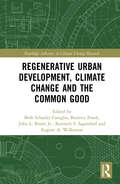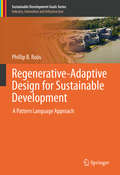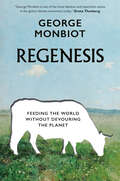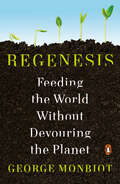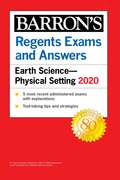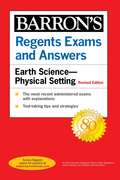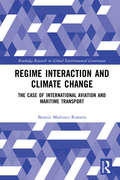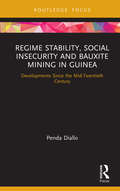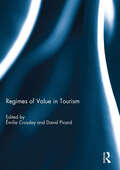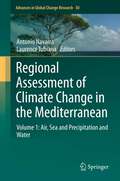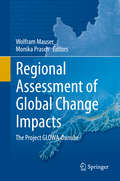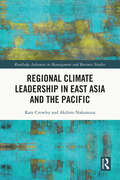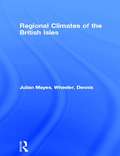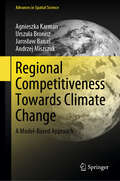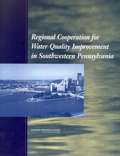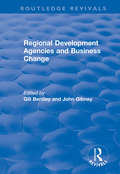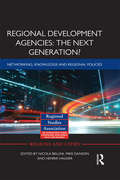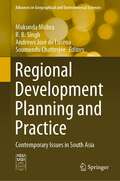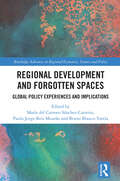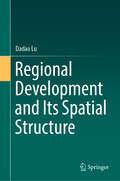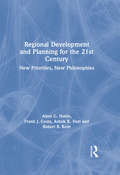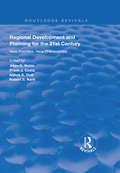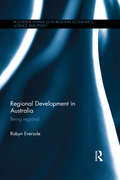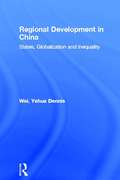- Table View
- List View
Regenerative Urban Development, Climate Change and the Common Good (Routledge Advances in Climate Change Research)
by Beth Schaefer Caniglia Beatrice Frank John L. Knott S. Sagendorf Kenneth Eugene A. WilkersonThis volume focuses on the theory and practice of the regenerative development paradigm that is rapidly displacing sustainability as the most fertile ground for climate change adaptation research. This book brings together key thinkers in this field to develop a meaningful synthesis between the existing practice of regenerative development and the input of scholars in the social sciences. It begins by providing an expert introduction to the history, principles, and practices of regenerative development before going on to present a thorough theoretical examination by known theorists from disciplines including sociology, geography, and ethics. A section on regenerative development practices illustrates the need to significantly advance our understanding of how urbanization, climate change, and inequality interact at every scale of development work. Finally, the book ends with a serious consideration of the ways in which integrated systems thinking in higher education could result in a curriculum for the next generation of regenerative development professionals. Regenerative Urban Development, Climate Change and the Common Good will be of great interest to students, scholars, and practitioners of regenerative development, climate change, urban planning, and public policy.
Regenerative-Adaptive Design for Sustainable Development: A Pattern Language Approach (Sustainable Development Goals Series)
by Phillip B. RoösIn this book, the author tests a regenerative-adaptive pattern language theory towards investigating the possibilities of a holistic, integrated design and planning method for sustainable development that incorporates the principles of regenerative design, as well as an adaptive pattern language that re-establishes our wholeness with nature, and considers the vulnerabilities of a changing landscape. The book examines an integral approach to contemporary theories of planning and design that explores the human-nature relationship patterns in social and spatial interconnections, between people and their natural environments. The interconnectedness of human and natural systems is used to scaffold possible solutions to address key environmental and sustainability issues that specifically address the need for patterns of behaviour that acknowledge the duality of ‘man and nature’. In 12 chapters, the book presents a holistic, regenerative-adaptive pattern language that encapsulates how communities can better appreciate landscape change under future climate effects, and acknowledges the importance to adapt to patterns of change of place and the environment and therefore inform the communities’ responses for sustainable development. The application of the regenerative-adaptive pattern language was tested along the Great Ocean Road region of the Victorian coast in Australia. The concluding chapters argues that for human settlements and cities to be resilient and sustainable, we must understand the interconnected patterns of human-built environments and natural systems, and how we function in a social-spatial dimension with these. The book is intended for practitioners and academic scholars with interest in sustainable development, regenerative design, pattern languages, biophilia, settlement planning, and climate change adaptation.
Regenesis: Feeding the World Without Devouring the Planet
by George Monbiot* GEORGE MONBIOT IS THE WINNER OF THE 2022 ORWELL PRIZE FOR JOURNALISM *What if there were a way to stop climate change and end global hunger at the same time?The way we feed ourselves is destroying the planet, and a collection of crises have brought the global food supply to its breaking point. But it doesn't have to be this way. With technology that already exists, we could sustainably provide everyone on the planet with a healthy diet. By cultivating hydrogen-eating bacteria, deep-rooted plants, and much richer communities of insects--coupled with existing technology to reduce our dependence on meat--we can dramatically reduce our carbon footprint, solve world hunger, and halt the sixth extinction at the same time.George Monbiot is an internationally renowned climate activist, widely known for bringing bold, creative thinking to the climate and ecological crises facing our planet. Now, he turns his attention to the global food system to offer a reimagining of the way we feed ourselves on a scale to fit the urgency of the problems we face.
Regenesis: Feeding the World Without Devouring the Planet
by George Monbiot&“This remarkable book, staring curiously down at the soil beneath our feet, points us convincingly in one of the directions we must travel. I learned something on every page.&” —Bill McKibbenFor the first time since the Neolithic, we have the opportunity to transform not only our food system but our entire relationship to the living world. Farming is the world's greatest cause of environmental destruction – and the one we are least prepared to talk about. We criticise urban sprawl, but farming sprawls across thirty times as much land. We have ploughed, fenced and grazed great tracts of the planet, felling forests, killing wildlife, and poisoning rivers and oceans to feed ourselves. Yet millions still go hungry. Now the food system itself is beginning to falter. But, as George Monbiot shows us in this brilliant, bracingly original new book, we can resolve the biggest of our dilemmas and feed the world without devouring the planet. Regenesis is a breathtaking vision of a new future for food and for humanity. Drawing on astonishing advances in soil ecology, Monbiot reveals how our changing understanding of the world beneath our feet could allow us to grow more food with less farming. He meets the people who are unlocking these methods, from the fruit and vegetable grower revolutionising our understanding of fertility; through breeders of perennial grains, liberating the land from ploughs and poisons; to the scientists pioneering new ways to grow protein and fat. Together, they show how the tiniest life forms could help us make peace with the planet, restore its living systems, and replace the age of extinction with an age of regenesis.
Regents Earth Science--Physical Setting Power Pack Revised Edition (Barron's Regents NY)
by Edward J. Denecke Jr.Barron&’s two-book Regents Earth Science--Physical Setting Power Pack provides comprehensive review, actual administered exams, and practice questions to help students prepare for the Physical Setting/Earth Science Regents exam. All Regents test dates for 2020 have been canceled. Currently the State Education Department of New York has released tentative test dates for the 2021 Regents. The dates are set for January 26-29, 2021, June 15-25, 2021, and August 12-13th. This edition includes:Three actual Regents exams onlineRegents Exams and Answers: Earth ScienceFive actual, administered Regents exams so students have the practice they need to prepare for the testReview questions grouped by topic, to help refresh skills learned in classThorough explanations for all answersScore analysis charts to help identify strengths and weaknessesStudy tips and test-taking strategiesLet's Review Regents: Earth ScienceExtensive review of all topics on the testExtra practice questions with answersOne actual Regents examThe Power Pack includes two volumes for a savings of $4.99.
Regents Exams and Answers: Barron's Regents Exams And Answers; Let's Review: Earth Science-the Physical Setting (Barron's Regents NY)
by Edward J. Denecke Jr.Barron’s Regents Exams and Answers: Earth Science 2020 provides essential review for students taking the Earth Science Regents, including actual exams administered for the course, thorough answer explanations, and comprehensive review of all topics. This edition features: * Five actual, administered Regents exams so students have the practice they need to prepare for the test * Review questions grouped by topic, to help refresh skills learned in class * Thorough explanations for all answers * Score analysis charts to help identify strengths and weaknesses * Study tips and test-taking strategies Looking for additional practice and review? Check out Barron’s Earth Science Power Pack 2020 two-volume set, which includes Let’s Review Regents: Earth Science 2020 in addition to the Regents Exams and Answers: Earth Science book.
Regents Exams and Answers: Barron's Regents Exams And Answers; Let's Review: Earth Science-the Physical Setting (Barron's Regents NY)
by Edward J. Denecke Jr.Barron&’s Regents Exams and Answers: Earth Science 2020 provides essential review for students taking the Earth Science Regents, including actual exams administered for the course, thorough answer explanations, and comprehensive review of all topics. All Regents test dates for 2020 have been canceled. Currently the State Education Department of New York has released tentative test dates for the 2021 Regents. The dates are set for January 26-29, 2021, June 15-25, 2021, and August 12-13th. This edition features:Five actual, administered Regents exams so students have the practice they need to prepare for the testReview questions grouped by topic, to help refresh skills learned in classThorough explanations for all answersScore analysis charts to help identify strengths and weaknessesStudy tips and test-taking strategiesLooking for additional practice and review? Check out Barron&’s Earth Science Power Pack 2020 two-volume set, which includes Let&’s Review Regents: Earth Science 2020 in addition to the Regents Exams and Answers: Earth Science book.
Regime Interaction and Climate Change: The Case of International Aviation and Maritime Transport (Routledge Research in Global Environmental Governance)
by Beatriz Martinez RomeraThe regulation of greenhouse gas emissions from international aviation and maritime transport has proved to be a difficult task for international climate negotiations such as the Paris Agreement in 2015. Almost two decades prior, Article 2.2 of the Kyoto Protocol excluded emissions from international aviation and maritime transport from its targets, delegating the negotiation of sector-specific regulations to the International Civil Aviation Organization (ICAO) and the International Maritime Organization (IMO), respectively. However, progress at these venues has also been limited. Regime Interaction and Climate Change maps out the legal frameworks in the Climate, ICAO and IMO regimes, and explores the law-making process for the regulation of international aviation and maritime transport through the lenses of fragmentation of international law and regime interaction. The book sheds light on how interaction between these three regimes occurs, what the consequences of such interaction are and how they can be managed to resolve conflicts and promote synergies. This book will be of great interest to scholars of international environmental law and governance, climate change policy and climate change law.
Regime Stability, Social Insecurity and Bauxite Mining in Guinea: Developments Since the Mid-Twentieth Century (Routledge Studies of the Extractive Industries and Sustainable Development)
by Penda DialloThis book explores how bauxite mining has affected local and national political dynamics in Guinea over the past 55 years, providing an overview of mining interactions with social, economic and political spheres. Guinea is amongst the world’s top producers of bauxite, and the country’s rich mineral presence has numerous implications on local communities and national policy. Guinea is an interesting and highly relevant case study in assessing the impact of bauxite mining on regime stability and social insecurity. The author offers a clear understanding of the role of mining during the Touré and Conté regimes and analyses how changes since the election of Condé in 2010 have affected the socio-political and economic development of Guinea. The author also offers analysis on how bauxite mining has led to the emergence of new forms of social contracts, sustained by mining companies instead of the state. Finally, the book argues that understanding the stabilising and destabilising potential of mining is key to ensuring long-term, sustainable, stable and inclusive growth of mineral-resource-rich countries. The book concludes by highlighting the relevance of the findings in Guinea for the wider African extractives sector. The book will be of interest to a wide range of scholars, including those working in the areas of African studies, political science, political economy, sustainable development and corporate social responsibility. The book will be relevant for academics, business actors, NGOs, policy-makers and students interested in the African mining sector.
Regimes of Value in Tourism
by Émilie Crossley and David PicardDrawing from ethnographic work in five continents, this book demonstrates how different regimes of value in tourism can coexist, collide, and compete across a varied geographic terrain. Much theory in tourism economics defines ‘value’ as a measure of monetary worth, a concept governing commodity exchange, and a gauge for tourist satisfaction. The research included in this volume shows that tourism not only feeds off existing conceptions of value as a monetary category, but that it is also instrumental in reproducing and reinforcing those subjective, morally heightened, and highly intangible values that make tourism and the tourism economy a complex social, cultural, political, and psychological phenomenon. The book pushes the debate about the tourism economy beyond a simplistic understanding of producer-consumer relations, instead suggesting a refocus on the social, spatial, and temporal lags in tourism production, and the ensuing differentiated regimes of values.This book was published as a special issue of the Journal of Tourism and Cultural Change.
Regional Assessment of Climate Change in the Mediterranean
by Antonio Navarra Laurence TubianaThis is the third volume of a three-volume final report, which thoroughly describes, synthesizes and analyzes the results of the four-year Integrated Research Project CIRCE - Climate Change and Impact Research: Mediterranean Environment, funded by the EU 6th Framework Programme. Conducted under the auspices of the National Institute of Geophysics and Volcanology in Rome, Italy, the study was designed to predict and to quantify the physical impacts of climate change in the Mediterranean, and to assess the most influential consequences for the population of the region.
Regional Assessment of Global Change Impacts
by Wolfram Mauser Monika PraschThis book provides an overview of the GLOWA-Danube research project from 2001 to 2011, a transdisciplinary initiative which explores the future of water resources in the Upper Danube Basin. It documents the purpose and unique approach, architecture, methodologies, scenarios and results of the project, creating a scientific knowledge base for the dialogue of stakeholders and scientists. The book offers a possible blueprint for successful global change science through integrative and transdisciplinary co-creation of knowledge and orientation for regional adaptation within the context of the Future Earth research program.
Regional Climate Leadership in East Asia and the Pacific (Routledge Advances in Management and Business Studies)
by Kate Crowley Akihiro NakamuraThis book defines regional climate leadership in East Asia and the Pacific as a novel addition to the climate leadership theory. It develops criteria for measuring such leadership on a country basis and uses these for assessing the efforts of developed, lesser-developed, and developing countries within these regions.The book suggests that regional climate leadership consists of leading domestic actions, leading actions within the region, leading actions that are regionally coordinated, and leading actions on a differentiated basis between countries with greater and lesser capacity, and with neighbourly intent. The book is policy and climate solutions-focused, and identifies opportunities for lesson learning and policy transfer for more effective mitigation and adaptation. These solutions take into account the widely varying and complex geographical, political, and institutional circumstances of the region.It is intended for a broad readership of climate policy actors, including policy professionals, academics, non-government researchers, and all who are looking for climate leadership solutions to the problems of accelerating climate impact in East Asia and the Pacific.
Regional Climates of the British Isles
by Julian Mayes Dennis WheelerGlobal climate and the effects of global warming are commanding unprecedented interest as climates grow more dynamic and changeable. How does global warming change patterns of climate? Why is the weather and climate of the British Isles so variable? Regional Climates of the British Isles presents a comprehensive and up-to-date survey of the diverse climate of the British Isles. <p><p> Examining the ways in which regional climates evolve from the interplay of meteorological conditions and geography of the British Isles, leading climatologists provide detailed explanations of the climatic characteristics of eleven regions of the British Isles. Climatic distinctiveness and local weather contrasts are described for each region, together with a summary of climatic data from 1961 to the present. <p> Reviewing the history and causes of climatic change and evaluating regional models, Regional Climates of the British Isles offers an important analysis of climatic variations. Examining future climatic change and its likely consequences, the authors acknowledge the need for regionally diverse responses to the greenhouse effect.
Regional Competitiveness Towards Climate Change: A Model-Based Approach (Advances in Spatial Science)
by Andrzej Miszczuk Agnieszka Karman Urszula Bronisz Jarosław BanaśThis book analyzes the competitiveness of European regions and presents forecasts for 2030 and 2100 under different climate scenarios. It examines the economic impact of climate change from a regional economic perspective and sheds light on various factors that influence regional competitiveness and development. Furthermore, the authors derive reflections on EU climate policy and policy recommendations from the empirical results, which will help both scientists and regional decision-makers to implement policy measures and develop successful adaptation processes for the regions and countries of the EU to climate change.
Regional Cooperation for Water Quality Improvement in Southwestern Pennsylvania
by National Research Council of the National AcademiesThe city of Pittsburgh and surrounding area of southwestern Pennsylvania face complex water quality problems, due in large part to aging wastewater infrastructures that cannot handle sewer overflows and stormwater runoff, especially during wet weather. Other problems such as acid mine drainage are a legacy of the region’s past coal mining, heavy industry, and manufacturing economy. Currently, water planning and management in southwestern Pennsylvania is highly fragmented; federal and state governments, 11 counties, hundreds of municipalities, and other entities all play roles, but with little coordination or cooperation. The report finds that a comprehensive, watershed-based approach is needed to effectively meet water quality standards throughout the region in the most cost-effective manner. The report outlines both technical and institutional alternatives to consider in the development and implementation of such an approach.
Regional Development Agencies and Business Change (Routledge Revivals)
by John Gibney Gill BentleyThis title was first published in 2000. Providing an introduction to contemporary regional economic development issues, this book analyzes whether the Regional Development Agencies (ROAs) have the organizational capacities to cope with complex business and economic development challenges.
Regional Development Agencies: Networking, Knowledge and Regional Policies (Regions and Cities #59)
by Nicola Bellini Henrik Halkier Mike DansonAcross Europe, regional development agencies (RDAs) have become a central feature of regional policy, both as innovative policy-makers and as the implementers of programmes and initiatives originating from the national or European level. By drawing on a combination of conceptual reflection, surveys, comparative research, and systematic use of critical case studies, this book provides a new point of reference by identifying key features of the current, and, indeed next, generation of regionally-based economic development organisations.
Regional Development Planning and Practice: Contemporary Issues in South Asia (Advances in Geographical and Environmental Sciences)
by Soumendu Chatterjee R. B. Singh Mukunda Mishra Andrews José de LucenaThis book, through a bunch of systematic and analytical notes and scientific commentaries, acquaints the readers with the innovative methods of regional development, measurement of the development in regional scale, regional development models, and policy prescriptions. Conceptualizing development as a regional process is a geographer's brainchild, and the sense of region has long been rooted deeply in the fundamental research practices that geographers are accustomed to. The geographical perspective of regions entails conceptualizing them nested horizontally as the formal region and hierarchical relationships in space with spatial flows or interactions as the functional region. In geographical research, the region works as a tool by serving as a statistical unit of analysis. More importantly, however, regions serve as the fundamental spatial units of management and planning by specifying a territory or a part of it for which a certain spatial development or regulatory plan is sought. This book addresses the complex processes in different regions of the world, particularly South Asia, to perceive the regional development planning involved and the sustainable management practiced there. The book is a useful resource for socio-economic planners, policymakers, and policy researchers.
Regional Development and Forgotten Spaces: Global Policy Experiences and Implications (Routledge Advances in Regional Economics, Science and Policy)
by María del Carmen Sánchez-Carreira Paulo Jorge Reis Mourão Bruno Blanco-VarelaThis book constitutes a novel contribution, combining recent theoretical developments and empirical contributions, as well as the recent and latest trends and challenges on the issue of Forgotten Spaces. Forgotten Spaces - like the Forgotten Regions, in particular - are spaces that in potential can and do create significant value (if their resources are properly rediscovered) and create many potential costs (if these spaces are increasingly neglected by economic agents). The editors have identified a gap in current research because there is not enough empirical evidence about these places, as well as about the role of their actors. Abandoning regions can lead to, for example, pollution, uncontrolled forest fires, vandalism heritage deterioration, and potentially untreated industrial facilities, carrying potential costs not only in environmental sustainability, but also in values such as landscape aesthetics. Thus, this book reflects on the dimensions of the identification of such Forgotten Spaces, on the design of policies focused on minimizing associated costs and on the scope of programs to promote these areas, not only for upgrading them but also for promoting their environmental sustainability. The comparative approach of the empirical part also allows knowledge and experience from diverse longitudes and latitudes. The editors highlight the richness of the experience of Latin American countries, the polarization and interesting experiences from several sector rediscovered in Europe, as well as the holistic cases coming from several African experiences. This book will attract the attention of academicians, politicians and ultimately the attention of all decision-makers who most likely are forgetting many of the Spaces around them.
Regional Development and Its Spatial Structure
by Dadao LuThis book describes the progress and prominent theories of regional development research in the past decades, especially in the past decade, discusses the industrial structure, spatial structure, resources, and environment, as well as a series of practical issues, and reveals the general characteristics of spatial structure evolution in the process of regional development. The research on the issues of regional development has become the frontier of relevant disciplines since the 1950s, and much progress has been made in the process of solving practical problems in social and economic development. This book provides an in-depth and systematic demonstration of the "point-axis system" theory of regional exploitation and development as well as the T-shaped structure of China's regional economic action in theory and practice and discusses the impact of location differential rent, restricted accessibility, technological innovation, etc., on regional development theoretically. This book is used as a reference for planning, scientific research, and teaching personnel in territorial expansion, regional economy, human geography, etc.
Regional Development and Planning for the 21st Century: New Priorities, New Philosophies (Routledge Revivals Ser.)
by Allen G. Noble Frank J. Costa Robert B. KentRegional Development and Planning for the 21st Century examines a number of related themes including: the traditional approach of local and regional planning initiatives developed within the context of national goals; the current decline of bi-polar political and ideological blocs; political decentralization and concurrent economic centralization including the growth of multi-national corporations; devolution of centralized planning powers to regions and localities, and the rise and acceptance of sustainable development concepts. The book is divided into five parts addressing: 1 - adjustments to political, economic and social change; 2 the problems of urban housing and housing and health; 3 - adjustments to environmental change, development policies and sustainability; 4 - the problem of rapid urban growth and mega cities; 5 - adjustments of changing urban networks. The contributors are from several countries worldwide and the chapters examine the issues at a global level.
Regional Development and Planning for the 21st Century: New Priorities, New Philosophies (Routledge Revivals)
by Ashok K. Dutt Allen G. Noble Frank J. Costa Robert B. KentPublished in 1998, Regional Development and Planning for the 21st Century examines a number of related themes including: the traditional approach of local and regional planning initiatives developed within the context of national goals; the current decline of bi-polar political and ideological blocs; political decentralization and concurrent economic centralization including the growth of multi-national corporations; devolution of centralized planning powers to regions and localities, and the rise and acceptance of sustainable development concepts. The book is divided into five parts addressing: 1 - adjustments to political, economic and social change; 2 the problems of urban housing and housing and health; 3 - adjustments to environmental change, development policies and sustainability; 4 - the problem of rapid urban growth and mega cities; 5 - adjustments of changing urban networks. The contributors are from several countries worldwide and the chapters examine the issues at a global level.
Regional Development in Australia: Being regional (Routledge Advances in Regional Economics, Science and Policy)
by Robyn EversoleIn Australia, regions are not just geographic locations, they are also cultural ideas. Being regional means being located outside the nation’s capital cities and in the periphery of its centres of power and influence. Regional development in Australia is thus significantly different than its European or American counterparts. However, surprisingly little has been written about the unique dynamics of development in Australia's regions; this book has been written to fill this gap. In recent decades the Australian government has made repeated policy efforts to achieve sustainable development in its non-metropolitan areas. Over the same period, those who live and work outside the nation’s capital cities have come to identify as regional Australians. This book takes an anthropological approach to understanding the particularities of regional development in Australia. It draws upon rich, on-the-ground observations of towns, industries, universities, development organisations, and communities across different settings to provide an in-depth understanding of the subject. This book will be of interest to researchers and practitioners concerned with regional development and policy.
Regional Development in China: States, Globalization and Inequality (Routledge Studies on China in Transition #No.9)
by Yehua Dennis WeiThis study systematically examines uneven regional development in China, focusing on three central agents: the foreign investor, the state and the region. Wei's findings have important implications for theories of, and policy towards, Chinese regional development. This book is a vital resource for those with an interest in transition economies.
